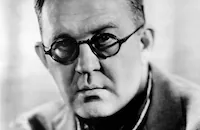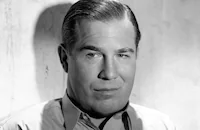Seas Beneath
Brief Synopsis
Cast & Crew
John Ford
George O'brien
Marion Lessing
Mona Maris
Walter C. Kelly
Warren Hymer
Film Details
Technical Specs

Synopsis
In August 1918, as the U.S. Mystery Ship No. 2 sails from Yorktown harbor, the commander, Lieutenant Robert Kingsley, U.S.N., tells his crew, the nature of their secret mission: they are to provoke a German U-boat, commandeered by Baron Ernst Von Steuben, who has built up a reputation as an ace destroyer of ships near Gilbraltor, to fire on them so that the U-boat will be drawn into firing range of the submarine the Mystery Ship has in tow. The crew composed of an untested university naval reserve unit and an experienced, crack gun team, are encouraged to practice a "panic drill," during which they will act like a merchant crew that his been shelled, running around screaming in fright and abandoning ship, to fool the enemy. When one of the gun crew acts out a tale of past heroism for the younger reservists, he falls into the ocean, and as he flails about, Ensign Dick Cabot, scion of an upper-class family, rescues him. Cabot receives the congratulations of the older men, who previously were skeptical of the reservists' abilities. They reach a port in the Canary Islands that Bob has learned is used for refueling U-boats. Although Bob issues orders prohibiting the drinking of hard liquor and the fraternization with women, the sailors immediately cavort with enticing Spanish women and accompany them to a bar. Bob is attracted to a beautiful blonde woman, who, unknown to him, is Anna Marie Von Steuben, the sister of the feared U-boat ace. After Anna Marie arranges to accompany German officers, including her sweetheart, Franz Schiller, on a trawler to visit her brother in his U-boat, Lolita, a Spanish singer and dancer, receives orders from Franz to get information about the Americans. As she performs in a cafe, Lolita flirts with Cabot, and after she leaves, Cabot follows to return her shawl. She entices the shy man to her room and gives him drugged wine. When he passes out, a German officer searches him and finds papers to confirm that he is an American officer. While he is unconscious, Lolita, uneasy about what she has done, kisses him. After Bob and Anna Marie walk together by the sea, Bob and the German officers recognize each other as enemy officers. Defiantly, they toast to their next meeting. The Americans return to their ship and set out despite failed efforts to locate Cabot. He revives in time to see them leave, and after he spies Lolita accepting money from the Germans for her services, he sneaks on their trawler as it heads to the U-boat. While Anna Marie greets her brother Ernst on the U-boat, Cabot sets fire to the trawler and hacks at a pump. When a German shoots and kills him, Franz reprimands the man. The officers then salute Cabot during his burial at sea. After the U-boat leaves, the leak on the trawler is discovered, and Anna Marie is saved in a lifeboat. Sometime later, the Americans find Cabot's body. They then locate the lifeboat, and Bob is forced to detain Anna Marie for questioning in relation to Cabot's death. She confesses that she is Von Steuben's sister and taunts the Americans. When the U-boat shells the Mystery Ship, the men begin their "panic party," and Anna Marie signals the U-boat to stay away. Bob orders a man to shoot her if she makes another move. When the U-boat refuses to come closer, Bob orders his sub to be cut free to fight the U-boat itself. As the U-boat shells the Mystery Ship again and the hold explodes in a fire, Bob and others rescue two men below. The U-boat then comes into range, and the Americans sink it. As German prisoners, including Franz and Von Steuben, are picked up to be sent to a detention camp, Bob tells Anna Marie that he's lost the only thing he ever cared about. Anna Marie assures him he will never lose that, but refuses when he suggests that they get married immediately. She explains that her country and people are in trouble and that she wouldn't be worth wanting if she abandoned them. She will not accept film taken of the two of them that Bob tries to give her, and says it will be a reason for her to come back. She then walks off with her arm around her brother as Bob watches.

Director

John Ford
Cast

George O'brien
Marion Lessing

Mona Maris
Walter C. Kelly

Warren Hymer
Gaylord Pendleton
Walter Mcgrail
Larry Kent
Henry Victor

John Loder
William Collier Sr.

Nat Pendleton
Maurice Murphy
Ferdinand Schumann-heink
Harry Tenbrook
Harry Weil
Terrance Ray
Ben Hall
Hans Furberg
Francis Ford
Kurt Von Fuerberg
Frank Walton
Earl Bowman
T. J. F. Von Blankerburg
George Harris
Bill Brande
Al Bennett
Dink Templeton
Bob Kyle
George Golden
Al Genereux
Bob Gillette
Joe De Pew
Leonard Davison
Robert Ford
Jack Martin
Jack Murphy
Bob Nelson
Edward Peil Sr.
Robert Shepherd
Harry Mount
Marvin Shector
Harry Strang
Hans Winterhalder
Anton Tell
Philip Ahlm
Harry Schultz
Crew
Joseph August
William Collier Sr.
William Collier Sr.
Capt. C. F. Cook <i>late Of Imp. German Navy</i>
Duncan Cramer
C. E. Crapnell
John Ford
Wm. Fox
Kurt Von Fuerberg
Maria Grever
James F. Hanley
R. L. Hough
Frank E. Hull
W. W. Lindsay Jr.
Joseph Mccarthy
Al Mcquarrie
Dudley Nichols
Ed O'fearna
Comdr. James Parker U.s.n. (<i>ret'd</i>)
Manuel Ponce
Troy Sanders
Farid Simaike
Wingate Smith
Sophie Wachner
Lee Zavitz

Film Details
Technical Specs

Quotes
Trivia
John Loder was paid an extra $1000 because he had to get a close haircut for his role.
The Navy placed at Ford's disposal a flotilla of destroyers, cruisers and submarines, as well as the services of naval personnel.
The three-masted schooner used as the decoy mystery ship was the same one used in the movies Sea Wolf, The (1930) and Painted Woman, The (1932).
Notes
This film was advertised as The Seas Beneath. According to information in the Twentieth Century-Fox Records of the Legal Department at the UCLA Theater Arts Library, the story, while never published, was copyrighted by the author on June 15, 1929. While the film was in production, a story by Commander Edward Ellsberg entitled "Pigboats," which director John Ford considered to be strongly similar to the story of Seas Beneath, appeared in the 15 November and December 1, 1930 issues of Adventure Magazine, according to the legal records. Although the story for Seas Beneath was copyrighted before "Pigboats," the Fox legal office decided not to take any legal action against Ellsberg. Fox legal counsel John H. Tracy noted that "we cannot see how [Ellsberg's] story will hurt our picture and on the contrary it may, in fact, aid it." "Pigboats" was later published as a novel, which became the basis for the 1933 M-G-M film Hell Below.
According to a Hollywood Filmograph feature article on the film, after the studio saw the early rushes from the production, they decided to increase the budget and try to make "as blood-stirring and thrilling an appeal against war as was All Quiet on the Western Front," Universal's successful film that was released earlier in 1930. Hollywood Filmograph also stated that the U.S. Government placed at Ford's disposal the services of Lt. William Quigley, Lt. Buckner, and Lt. Day, in addition to a flotilla of submarines, cruisers and destroyers. According to the pressbook for the 1932 Fox film The Painted Woman, the three-master schooner "Metha Nelson" was used in Seas Beneath, The Painted Woman and the 1930 Fox film The Sea Wolf (see AFI Catalog of Feature Films, 1921-30; F2.4868). Seas Beneath includes occasional titles in English explaining spoken German dialogue. According to Variety, this was the first feature film appearance of Marion Lessing and Walter C. Kelly; Lessing previously had appeared in shorts. In a modern interview, Ford claimed that the head of the studio assigned him Lessing because he thought she could speak German. Ford noted that she could not and also asserted about the film that the studio "cut the hell out of it." According to Film Daily news items, Marguerite Churchill was originally set to play the role that Lessing took, but she gave it up to take the leading female role in The Spider (see below). According to the Fox legal records, some scenes were shot at the isthmus of Santa Catalina Island. The legal records reveal that John Loder was paid an extra $1,000 because it was necessary for his hair to be removed from his head for the role he played. On November 12, 1936, the PCA approved certification for the re-issue of this film.












